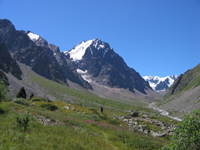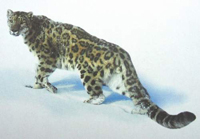 |
 |
Almaty Reserve |
|
|
 |
Most of the reserve area – around three quarters – is located on the northern slope of the Zailiiski Alatau. The western border in this part goes along the Levyi Talgar River , the northern border along the Pravyi Talgar River , and the eastern one goes along the ridge of a high branch which divides the valleys of the Issyk and the Turgen. This part is more than 32 km long eastward. The remaining area is on the southern slope of the Zailiiski Alatau. The southern border of the reserve goes near the Toguzak Pass along the Yugo-Vostochnyi Talgar River and upstream the Chilik River to a branch between Kosbulak-2 and Tamchi brooks. The reserve is fringed with a 2-kilometer security area.
Geographical Properties
The reserve is on the slopes of the central part of the Zailiiski Alatau – a tall ridge in south-eastern Kazakhstan . With neighboring ranges of Ketmen, Kungei-Alatau, Kirgizski, Talasski, etc., the Zailiiski Alatau belongs to Northern Tien Shan Province .
Major landscapes of the reserve are typical for the Northern Tien Shan: strongly dissected slopes with steep and sharp ridges and narrow and deep gorges, small spots of broad-leaved and spruce forests, vast areas of subalpine meadows with archa shrubs, and, finally, huge massifs of bare slides, moraines and rocks.
The slopes, crowned with a powerful ridge of ice-covered snowy tops, contrasting the foothill deserts, are luring in all seasons. The main range of the Zailiiski Alatau reaches its peak height in the reserve and does not get lower than 4,200 m above sea level. This is where most tops of the range higher than 4,500 m are concentrated. Especially beautiful and menacing ones are the tall peaks of Bogatyr ( 4,626 m ), Kopr ( 4,631 m ), Aktau ( 4,686 m ), and Metallurg ( 4,600 m ). Peak Talgar ( 5,017 m ) is the most impressive as the highest peak of the range, visible event from foothill plains dozens of kilometers away.
The head of the Issyk Gorge has two highland moraine lakes – Ak-Kol (Beloye), at 3,140 m , and Muz-Kol (Ledyanoye), at 3,400 m . There are some garish glaciers, too: Zharsai, Palgova, Grigoryeva, etc.
The reserve has intensive modern glaciation. The Issyk Tiver basin only has 49 glaciers (total area 53 km2). In total, there are 160 glaciers in the reserve (with the total area of 233.7 km2) out of 466 known in the Zailiiski Alatau.
The river network is well-developed. Rapid torrents (5 to 7 m wide and 1 m deep) run along the bottoms of most gorges. There are also a lot of springs. The northern part has the biggest (16 to 28 km long) rivers: the Issyk, the Levyi Talgar, the Pravyi Talgar, anf the Srednyi Talgar. The southern part has the Yugo-Vostochnyi Talgar ( 13 km ) which begins in Bogatyr Glacier, and its tributary, the Yuzhnyi Issyk ( 10 km ) flowing down from Korzhenevskogo Glacier. Both rivers are full-flooded, especially in the warm season. The Yugo-Vostochnyi Talgar and the Zhangyryk merge to form the Chilik River – the biggest one in the Northern Tien Shan . The Chilik flows within the reserve for about10- 12 km.
 Climate
The climate of the reserve is strongly continental and typical for the Northern Tien Shan . Its main features include significant solar radiation and a complex seasonal air circulation. The average annual temperature varies from 6.8 ° in the lower part to 0.8 ° at the upper limit. Minimum average monthly averages are recorded in January (-4.3 ° in the lower part to -9.7 ° in the upper part), and maximum temperatures, in July (18.1 ° to 10.6 °). Average annual precipitation is 830 to 870 mm , including 570 to 640 mm in the warmer period. The humidity factor changes upwards from 1.15 to 1.95. the snow cover stays for 160-190 days and gets 60 to 80 cm . The spring is characterized by a fast increase of average daily air temperatures and heavy precipitation. Early summer (June) usually has cool weather with a lot of sun and moderate precipitation. July and August have little precipitation due to the draught period (even at 2,500 m or higher). In late September, the fall is felt thoroughly. The average daily air temperature gets down significantly. The fall has clear weather most of the time. The first snow in the lower part falls in late October or earl November, and the winter sets at 2,500 m or higher. Climate
The climate of the reserve is strongly continental and typical for the Northern Tien Shan . Its main features include significant solar radiation and a complex seasonal air circulation. The average annual temperature varies from 6.8 ° in the lower part to 0.8 ° at the upper limit. Minimum average monthly averages are recorded in January (-4.3 ° in the lower part to -9.7 ° in the upper part), and maximum temperatures, in July (18.1 ° to 10.6 °). Average annual precipitation is 830 to 870 mm , including 570 to 640 mm in the warmer period. The humidity factor changes upwards from 1.15 to 1.95. the snow cover stays for 160-190 days and gets 60 to 80 cm . The spring is characterized by a fast increase of average daily air temperatures and heavy precipitation. Early summer (June) usually has cool weather with a lot of sun and moderate precipitation. July and August have little precipitation due to the draught period (even at 2,500 m or higher). In late September, the fall is felt thoroughly. The average daily air temperature gets down significantly. The fall has clear weather most of the time. The first snow in the lower part falls in late October or earl November, and the winter sets at 2,500 m or higher.
Most of the reserve area is difficult to access, and the Talgar Massif is only accessible for mountain climbers. Roads, good enough for 4WD vehicles, run along the reserve borders in the lower part of the Levyi Talgar ( 6 km ), the Pravyi Talgar ( 8 km ) and the Issyk ( 7 km ). There are few paths, and they are all very bad and rought.
Vegetation
In the Northern Tien Shan system, the Zailiiski Alatau is singled out as a special Zailiiski orographic area. The vegetation is clearly distinguished between northern and southern slopes of main ranges. Plateau-like summits in the highlands and inter-mountain valleys also have their own geological and botanical peculiarities.
The flora in the reserve has 930 species of 406 genuses of 77 families. The reserve has 13 species of trees, 63 species of shrubbery, 4 species of subshrubs, 3 species of dwarf subshrubs, 3 species of liana, 79 annual plants, 50 species of biennial plants, and 712 species of perennial plants.
Endemics of the reserve include: Albert flag, goat’s-wheat, Almaty oxytrope, glazed parsley, Semenov’s cortuse, Alatau speedwell, Almaty jurinea, Kumbel hawkweed. Endemics of the Northern Tien Shan include 15 species: Tien Shan poppy, saffron erysimum, Almaty hawthorn, Talgar oxytrope, Trans-Ilian cusinia, Dzhungar dandelion, Trans-Ilian wormwood, steppe peony, Ostrovsky’s tulip, etc. The flora of the reserve has 18 relics: Shrenk’s firtree, Caucasian hackberry, golden adonis, saffron erysimum, Seever’s apple-tree, green strawberry, common apricot, Schmalhausen’s milkvetch, glazed parsley, etc.
Five species of plants growing in the reserve are listed in the World’s Red Book: glazed parsley, Ostrovsky’s tulip, goat’s-wheat, and Semenov’s kaufmania, and 23 species are listed in the Red Book of Kazakhstan: Kolpakovsky’s tulip and Ostrovsky’s tulip, orange erysimum, Wittrock’s rhubarb, golden adonis, Semenov’s cortuse, Alatau speedwell, etc.
The reserve has poisonous plants, too – about 20 species, Dzhungar monkshood being the most known of them. It grows in the spruce forest belt, big-grass meadows and river banks.
Spruce forests and open forests of Shrenk’s fir-tree occupy an area of about 5,000 hectares at 1,400 to 2,800 m . They are most located on the northern (more rarely on the eastern and western) slopes of various height. Archa shrubs are most common for the highlands. Archa is the Turkic name of arborescent and shrubby junipers of the cypress family.
 Wildlife Wildlife
According to estimates, there are about 200 species of birds in the reserve. The reserve has 38 species of mammals. The alpine meadows are inhabited by the grey marmot, with frequent colonies in the upper reaches of the Levyi Talgar.
The Tien Shan brown bare is common in the reserve, mostly inhabiting spruce forests. Its population in the reserve is rather stable: 20 to 25 animals. The snow leopard mostly lives in the alpine belt, and only in the winter it follows the ibex down to the forest and meadow belt. The reserve has 2 or 3 families of this rare animal. Spruce forests have the Turkestan lynx (around 10 animals). They live on roe deer and (more rarely) young wild boar and ibex.
Since 1970, the reserve has had 2 to 4 families of wolves. The boar is common for the reserve, numbering about 60 to 80 animals. In broad-leaved forests along the Pravyi Talgar and the Levyi Talgar, the pigs have very good fodder and reliable hideouts. The roe deer is common up to the upper border of the forest but more numerous in broad-leaved forests on the southern slopes thickly grown with shrubs. Its population varies between 400 and 650 animals, significantly reducing after severe and snowy winters.
The population of the Siberian deer is gradually growing. In 1968-1972, shed horns or footprints could be seen occasionally. Nowadays, the reserve (mostly spruce forests) have groups of grazing Siberian deer of up to 10 animals on a daily basis. All in all, it has about 120 deer.
The Siberian ibex is the most numerous ungulate in the reserve. According to the annual aerial census, the upper parts of the reserve are inhabited by 600 to 700 ibex. Larger flocks, 100to 150 animals, are formed in the winter.
|
 |
|
 |
 |
|
|
|
|
 |
|
